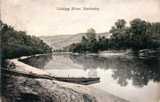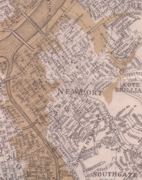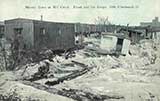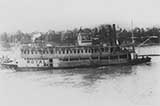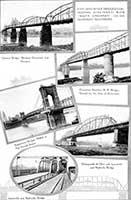
The very first steam boat that ever passed down the Ohio River was the New Orleans.
She encountered swarms of migrating squirrels swimming across the river, snow
when she got to Louisiana,
Indian attacks, The
Great Comet of 1811, and
the biggest earthquake ever known to hit the Midwest.
The Wikipedia article is
here; lots more sources are
at this site.
Northern Kentucky connection is here.
In 1811, The steamer New Orleans, stopped at Maysville, where 1035 people
boarded the boat for a closer look,
at Manchester, 486. School children toured at a 20 minute stop in
Vevay, Indiana. The New Orleans tied up for the night at Madison.
Our image is a drawing, obviously not a picture.
While 1811 saw the first steam boat, the idea caught on very quickly. Witness this list of 60 (!) steamers plying the waters of the Ohio a mere 8 years later. from The Brooksville (Indiana), Enquirer, August 13, 1819, reprinting from the Cincinnati Gazette. Sorry, it was the best quality we could get. |
| Here's the list of steamers and tows working Cincinnati in 1866. |
![]()
How that 1811 earthquake effected Northern Kentucky is discussed at this site.
| “A MIGRATION OF SQUIRRELS A migration of Squirrels is not a common occurrence, yet
there are few old men among our readers who have now witnessed
several instances of the kind. We remember hearing some of the
older citizens of Bracken county telling of a migration of squirrels
from Ohio to Kentucky, when many thousands were killed on swimming
the river. On reaching the shore they were so exhausted that they
were easily dispatched with clubs. The Rising Sun (Ind.) Recorder says that a similar migration is now occurring, only this time its
from Kentucky to [Indiana]. The Recorder says Harrison Co.,
Ind., and some portions of adjoining counties are being overrun with
squirrels. They are daily crossing the Ohio from Kentucky, and soon
seem to be extending themselves across the country in northward
direction. There was a similar but greater migration in 1833.” From the Covington Daily Commonwealth, September 30, 1877
Do squirrels really migrate? One scientist's conclusions, at this site. |
![]()
![]()
For a description of the types if boats on the river in 1810, we suggest this account (pdf)
from from Christian Schultz' 1810 Travels on an Inland Voyage
![]()
Immigrating down the Ohio was not without dangers. Indians were talented
and creative in luring boats to shore, and they weren't very happy that the white
settlers were immigrating in violation of treaties.
| “Capt. T.B. Johnson, of Hamilton, Ky., started his flatboat for New Orleans and the lower coast trade, Saturday. It was purchased from and fitted up by Mr. J. F. Keeling for $550, and will be loaded with hay and produce at Rising Sun, Indiana, and below that point. Mr. Wm. Miller, of New Orleans, left Sugar Creek Saturday, for New Orleans, with a flatboat laden with corn, hay and produce.” Courier-Journal, March 10, 1874 |
Augusta's Philip Johnson Buckner takes a flatboat toward New Orleans. You can read his Northern Kentucky log entries.
![]()
 |
 |
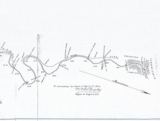 |
| These maps show the Licking River from Covington to Falmouth, and were drawn by Major W. H. Bixby, of the US Corp of Engineers in 1899. |
||
Somewhere along the Licking River, c. 1910.
 |
| An anonymous author wrote a navigation guide to the Licking in 1818. We've transcribed it for you. |
![]()
| A wonderful Ohio River Steamboat site is the Cincinnati Public Library's Inland River Photographs. They estimate 19,000 photographs, not all of which seem to have been imaged. See that site here. | On the other hand, the Murphy Library at the University of Wisconsin at Eau Claire houses the DuPage collection, and includes over 40,000 steamboat photographs. You can find their site here. |
In 1853, The Catholic Telegraph looked back on the history of steamboats
![]()
| This likely isn't a location in Northern Kentucky, but it is absolutely representative of a scene you might see on the Kentucky or Licking Rivers, as downstate Kentuckians rafted their logs and sent them downstream to sawmills in Butler, Carrollton, and other locations. |
 |
 |
| The H. P. Wells ran packet service along the Maysville/ Augusta/New Richmond part of the river |
The Dixie hauled coal along the Kentucky River in the 1910-15 era |
The first scheduled packet service on the Ohio River was in 1794. Read the ad here.
![]()
The General Pike docked at Covington
The steamer General Pike delivers emergency relief in the flood of 1884 from Lawrenceburg,
Ind. to Madison, including the towns on the Kentucky side. Story here.
![]()
| The Ohio and the Oswego June 5, 1888 |
The Ohio, at Marietta July 17, 1891 |
The E. A. Woodruff November 22, 1882 |
| These are snag and dredge boats. Before today's Ohio River levels, downed trees and other debris could effectively prevent river commerce, making it necessary for a small fleet of boats that cruised the river to remove debris, and dig out channels. These “snag boats,” a.k.a. “Uncle Sam's Tooth Pullers,” were common sights on the Ohio at one time. None of these were taken in Northern Kentucky, altho these exact boats could be seen in the area. | ||
![]()
The Granite State
| A Cincinnati Enquirer reporter aboard the steamer Granite State goes from Cincinnati to Maysville in the 1884 flood, and describes conditions here. Mostly, not exclusively, Ohio towns. |
| The Cincinnati Commercial Gazette also had a man on the Granite State, who filed this story. |
The Clermont Sun's coverage of the 1884 flood in Ohio and Kentucky.
| Because of the 1883 flood, the New York Herald raised a bunch of money, rented a steamboat to cruise down the Ohio, and gave out cash to those who needed it. Here's the story of the of their steamer, The Lily, as she went from Florence, (across from Warsaw), to Louisville, with a stop in Milton. The coverage of her trip before then is kinda thin. | ||
| Cincinnati's Noah Meeker kept a book that visually lists every city, landing and boat wreck on the Ohio River between Cincinnati and Louisville. The Cincinnati Library has made it into a pdf, and you can see it at their site, here. | ||
| A chart of the distances along the various points along the Kentucky River is here, a brief chart with details of the locks and dams along the Kentucky is here, and a more extensive chart is here. |
||
| Henry Clay's funeral steamer came down the Ohio past Northern Kentucky, and was a sight to behold. | Remember the first major crowd with fireworks on the Cincinnati/Covington/Newport riverfronts? No, not WEBN in 1977; Millard Fillmore in 1856. Read an account of it here. | |
| The role of Captain Anthony Meldahl during a 1905 Congressional Tour of the Ohio River, in contemplation of building a series of locks and dams, is explored here. (pdf) | “There are about 300 steamers plying on the Ohio River between Pittsburgh, Penn., and Carrollton, Ky. These boats during the past year carried 2,367,659 passengers.” from Maysville's Evening Bulletin, January 12, 1897 | |
| A detailed, contemporary map of the Kentucky river is here (pdf). | Commercial boats on the Ohio in 1836 paid fees according to a schedule. | |
| Reminiscences from a career on the Kentucky River, here. (pdf) | Otto Smithers talks about Kentucky River steamers, here. (pdf) | The old river men were NOT fans of all these bridges that were being built along the Ohio. |
| Brooksville's Leila Willis Poage wrote a thesis at UK about the Red Cross in Campbell County in the 1937 Flood. We've reproduced an excerpt (pdf) that deals with a description of the flood itself. | A traveler describes the Ohio River between Covington and Carrollton in 1912, here. | In 1775, Nicholas Cresswell rafts down the Ohio. His journal entries on passing Northern Kentucky are here. |
| A scientist from 1884 discusses Ohio River floods, past and current. | Floods, before 1883. | |
| Glenn Finch's Floating Palaces of the Ohio River is here. (pdf) | Did the early floods bring out tourists? You bet. Read about it here. | Wm. Lytle travels from Maysville to Louisville in 1780; encounters Indians. Story's here. |
Extent of the 1884 Flood ( a big image)
 |
|
| Map of the Extent of the 1884 Flood | |
The 1884 flood saw 350 houses under water in Covington, 2,100 in Newport, and 400 in Dayton and Bellevue. |
![]()
| The 1913 floods were caused by huge amounts of rain in central Ohio on March 23-27, along with some pretty good totals in Northern Kentucky |
The Lexington Leader's coverage of the 1913 flood: March 29, March 30, and March 31.
The 1913 flood coverage from the New York Times.
The 1913 flood coverage from the Kentucky Post.
| “There's only one good point that I can find in the [1937] flood. Old-timers are forever silenced about the flood of '84. There are no more lurid tales about the flood of 1913. The flood of '37 is the greatest of them all.” J. Sherman Porter, Jr. in the Lexington Leader. |
![]()
THIS CHART tells you everything you need to know about the severity of the 1937 flood.
“The currents come riding in, at first picking up straws and dead leaves, and little sticks, and then boards and pieces of firewood and whole logs, and then maybe the hen house or the barn or the house itself. As if the mountains had melted and were flowing to the sea, the water rose and filled all the airy spaces of rooms and stalls and fields and woods, carrying away everything that would float, casting up the people and scattering them, scattering or drowning their animals and poultry flocks. The whole world it seemed was cast adrift, riding the currents, whirled about in eddies, the old life submerged and gone, the new not yet come.” Wendell Berry, in Jayber Crow |
List of the highest Ohio River levels for every year for which there are measurements, here.
Years of the 15 Worst Cincinnati Floods, here.
1937 Flood levels by the hour in Cincinnati, here. You'll note the chart lists the highest measured water level at 80.0 feet. The official high water mark is 79.99 feet at 2 am on January 26. We've heard that the official mark is fudged below 80 feet because there were insurance policies that would not pay if the water was over 80 feet, but that makes little sense to us. We've also read that the number was kept below 80 feet to make buying flood insurance in the future easier. Meh. We await a definitive explanation. Or, maybe the official mark is true. |
1937 Flood levels, height and duration at various points along the Ohio, here.
| from Collin's History of Kentucky, December 1, 1827: “Rain falls every day for over three months. up to March, 1828. In 40 day prior to to January 9, there were but 4 days of sun. High water in the Ohio river, about five feet lower than the highest known.” |
| from Collin's History of Kentucky, February 9, 1832: “Greatest flood ever known in the Ohio river; many of the towns entirely and large portions of all of them partially, submerged, driving the inhabitants from their homes, and drowning some; many dwelling houses, stables, barns, outhouses and grainstacks carried off, and immense loss of fencing, saw logs, plan, horses, cattle, hogs, sheep, corn, hay, etc.” |
Was the Ohio River at 112 feet in 1789? Maybe.
Also over 100 feet in 1774? The Indians said yes,
here.
One man describes floods from 1772 to 1832, here.
 |
 |
| Low water in 1887 from the Vanishing Cincinnati Facebook Page |
The Ohio River, August 24, 1883,
at 1 foot, 11 inches, the all time record low water mark. More on this picture is here. |
You could also wade across the the Ohio in 1895.
“It is said that the Ohio river can be waded at many points.” Boone County Recorder, September 30, 1908

A service needed by many after the 1937 flood
from the Kentucky Post, February 4, 1937
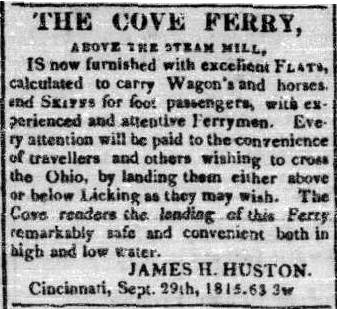
Western Spy, October 6, 1815
You can choose where the 1815 Cincinnati ferry crosses.
A film about the 1937 Flood by Cam Miller
![]()
Today we have Markland and Meldahl, but these two dams
replaced nine - 9! - earlier locks and dams. Details
here.
This is a bear trap or wicket style lock used by the early Ohio River Dams.
To lock thru, they lowered the gate, and you floated over it.
![]()
There are a series of video's that Cincinnati's Channel
12 produced on the 1997 Flood
One covers Silver Grove, Falmouth, Newport, and other areas, and is the first of a
multi-part series on YouTube. WLW also has a series on the 1997 flood.
![]()
There's motion picture footage of the ice of the winter of 1917-1918!
An appendix to Zadok Cramer's
The Navigator (Wikipedia), listing the items shipped
down the Ohio to Louisville from November 24, 1810 to January 24, 1811,
on 197 flat boats and 14 keel boats. It's a fascinating view of what
people
were buying and selling at that time. (Understand that "do." meant
"ditto.")
![]()
| Tom and Mary Greene | The Chris Greene, left, Vs. The Betsy Ann |
| Read about the race here. | |
| You can find
lots more about Tom Greene, Mary Greene, the Greene Line, and the
many different steamers they owned, at Don Prout's Cincinnati Views, here. |
|
![]()
| Riverboat Captain Don Sanders shares some river memories at the NKY Tribune's website. |
![]()
| “Painful Rumor — Reported Explosion of the Steamer Dove. — We learn from Capt. Chas. F. Reynolds, who came down on the Cincinnati mailboat, that a gentleman came on board at Warsaw, who stated a report had reached there that the Kentucky river packet Dove had exploded at Drennon last evening, by which Capt. Saunders, Robert Hetton, the pilot, and John Bowen, the barkeeper, were killed, and three persons were missing. Capt. Reynolds inquired at Carrollton, when the mailboat arrived there, but could hear nothing of it. There is, however, no direct communication, except by river, between Drennon and Carrollton, while there is a good road between Drennon and Warsaw. The Dove left Frankfort yesterday for this port, and as she had not arrived at 1 o'clock this morning, we fear that the rumor may prove true.— Louisville Journal” Sacramento Daily Union, July 2, 1857 |
![]()
|
“Ferries. - Since the completion of three bridges over the Ohio. the ferries have lost most of their former business. The usual fare for pedestrians is two cents; but the ferries make half-hourly trips between midnight and daylight, during which time the fare is five cents. There are now four lines, as follows: Anderson's Ferry, six miles down the river, used principally by Kentucky farmers bringing their produce to market; Covington Ferry, with its Cincinnati landing at the foot of Central Avenue; Ludlow Ferry, starting from the foot of Fifth Street and landing at the eastern limit of Ludlow; and the Newport Ferry, with its landing in this city of at the foot of Pike Street. Skiffs and small craft carrying passengers at reasonable rates are available at all places on the river from Columbia to Riverside.” King's Pocket-Book of Cincinnati, 1880 |
![]()
“The principal places we passed, for the first sixty miles, were Columbia, Point
Pleasant, Neville, Higginsport, Ripley, and Aberdeen, in Ohio; and Mechanicsburg,
Belmont, Augusta, and Charleston, in Kentucky. ”- an early, unknown travelogue
![]()
In 1866, George Hawes published a directory of cities up and down the Ohio. Here are his comments about the ones in Northern Kentucky. |
|||||
| Maysville | Charleston | Dover | Augusta | Fosterville / RockSpring | Belmont |
| Dayton | Newport | Licking River | Covington | Claysville | Petersburg |
| Belleview | Big Bone / Hamilton | Warsaw | Ghent / Carrollton | Prestonville | |
![]()
The City of Cincinnati in better days.
 |
 |
 |
 |
 |
| The City of Cincinnati destroyed in the ice, 1917-1918 | ||||
The City of Louisville in better days.
 |
 |
 |
 |
The City of Louisville destroyed in the ice, 1917-1918 |
|||
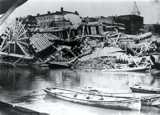 |
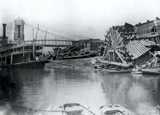 |
| The City of Louisville | City of Cincinnati |
 |
 |
 |
| The Greenland succumbs to the ice | The Greenland in better days. | |
 |
 |
| The Reba Reeves succumbs to the ice | The Reba Reeves in better days. |
 |
 |
| The Florence Marmet succumbs to the ice | The Florence Marmet in better days. |
 |
 |
 |
 |
Ice, 1917-1918 |
|||
 |
 |
| Anderson Ferry in the 1918 ice | Ice gorge at Ludlow, 1918 |
| February 7, 1918 That's the steamer Julius Fleischmann tied up in the Licking |
January 4, 1918, Mouth of the Licking |
 |
| The John Dana, in the ice at Sugar Creek Bend, Gallatin County, December, 1892 |
| The riverboat Calumet (of which we are unable to find a picture), was built in Madison, Indiana in late fall of 1876. Her initial voyage was to Cincinnati, where she encountered ice, was frozen in, and drifted with the ice back to Madison, where she sank, and lies to this day at the bottom of the Ohio. Sad details here. (pdf) | In 1918 there was a huge ice dam that formed at the big Ohio River bend at Sugar Creek, in Gallatin county. It effectively dammed up the Ohio, creating high water all the way back to Cincinnati. Nothing scared the old time river men like ice, because when an ice dam breaks, and they always break, they create fast moving torrents not only of water, but of giant pieces of ice that will destroy a steamboat or anything else in their path. When the 1918 dam broke on January 30, 1918, the water in Cincinnati fell from 62 feet to 20 feet in 2 hours, destroying any number of steam boats. Imagine what was happening downstream. More on the ice of 1917-1918. |
| Fourteen steam boats wrecked in the ice of 1917-18, here. But the revised count is 36, here. | |
You can read about the ice of 1879 here.(pdf) |
Read about the destruction by the ice of 1856 here and here and here and here and here. |
| The ice of 1827 came with a fiddler. | |
| The ice reports of 1918 from the Boone County Recorder are here. | Waterways Journal had this excellent write up on the 1918 Ohio River Ice at their web site. |
| The Corp of Engineers has tracked (pdf) ice, and its severity on the Ohio at Cincinnati from 1874 to 1988. | |
| Dispatches about the 1873 ice are here, here, and here. | An overview of ice in the Ohio historically. |
![]()
The Merchant Boats
 |
 |
 |
 |
| Church Boat | A Preaching Boat, The Messenger |
Photographer J. P. Doremus |
Dormus Gallery From a Facebook post by Don Sanders |
| A story from Mrs. Ira L. Arnold of Squiresville, in Owen County: “An enormous dead whale as brought to Ball's Landing [Perry Park] on a big fat kind of flat boat and anyone wanting to see this huge whale was welcome. I believe the fee was 25 cents. Our teacher made arrangements for all the pupils to go from the Squiresville school. We were allowed to go into the big mouth that was propped open. I remember it quite well. There was a giant chair in the mouth, but no one wanted to sit down.” Could it have been made of papier-mache? “Certainly not. The smell was all we needed to know it was real.” | |||
 |
 |
 |
 |
| Williams Floating Gallery From a Facebook post by Will Lack |
Daguerreotype Boat, 1858 | God's Bible School Sinks. From a Facebook post by Bethany Granville Dearwester |
Floating Theatre in Maysville |
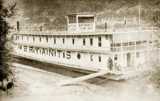 |
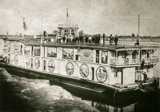 |
||
| Showboat Bryant. Details. From a Facebook post by the Clermont Society Historical Society | French's Showboat From a Facebook post by the Clermont Society Historical Society | ||
 |
 |
||
| Price's Floating Opera, somewhere on the Kentucky River |
Showboat New Era, at unknown location | Grocery Boat | Printer's/Jeweler's Boat |
 |
 |
||
| The Barrette Portrait Co. |
20th Century Floating Theatre | Museum | |
One old-timer recalled “gathering up old horseshoes and other scrap iron around the shop and taking them to the dish boat, where his mother then collected dishes in trade” Another one remembers as a boy that the arrival of a dish boat “was a signal for all the boys to start cleaning up the town. The attics, sheds, and smokehouses were soon disgorged of all the scrap metal (an in some cases good things our fathers had laid by), papers, rags, etc., and there was a steady stream of wheelbarrows and other kid-type rolling stock toward the river and the junk boat. Of course we were rewarded with few pennies for the proceeds from our pilfering and were then encouraged to reinvest our pennies in some item of stock from the boat store. Our mother’s always seemed pleased with the present of a dish, which didn’t match anything, which we had bought especially for her.” Note the stuff on the roof's of the two Glass Boats below. |
|||
 |
 |
 |
 |
| Photographer | Umbrella Maker | Saw Mill Boat The Mary H., c. 1895 |
Glassware and Queensware |
 |
 |
Up and down the Ohio and Kentucky Rivers, towns were visited by all kinds of merchants, services, and attractions passing by on various riverboats. In addition to those shown, there were boats for prize fights, taverns, tinware, classical musical shows, scrap metal buyers, ice sellers, prostitution, camp meetings, groceries, and much, much more. Of any type of business of the period, somebody likely tried it on a boat. |
|
| The Ivory Wood #3, a.k.a. |
The Ivory Wood #4, | ||
| a.k.a. The Glass Boat, ...because it sold glassware up and down the river. | |||
![]()
The packet Royal was a regular on the Kentucky River. Details.
![]()
 |
 |
 |
 |
 |
| Maysville
|
Augusta
|
Foster
|
Melbourne
|
Cincinnati
|
 |
 |
 |
 |
 |
 |
| Constance | Petersburg | Sugar Creek | Ghent | Milton | Wise's Landing |
Detailed maps of the Ohio River, showing every little landing and creek name.
| Springdale | Maysville | Augusta | Foster | Newport |
1877 maps of the Ohio River, showing
every little landing and creek name, and then some.
They only cover the eastern side of NKY Views.
![]()
| from Collin's History of Kentucky, December 1, 1840: “M. R. Stanley, resident engineer of the Kentucky river improvements, in his report states “that in nearly all the excavations, in building five locks and dams, detached teeth and bones of the mammoth were found, in a state of excellent preservation; at depths generally of 50 feet below the surface of the ground and at distances of 100 to 150 feet from the margin of the river.” |
Kentucky River Map, showing Locks and Dams, 1975
For a brief time, The Kentucky River was going to be the boundary of the British Territory of Vandalia.
You can read more about it at Wikipedia, here.
![]()
The steamer City of Louisville crows about its fastest time on record between Cincinnati and Louisville in 1894:
9 hours 42 minutes. Is it still the record for steamers? Don't know.
 |
 |
 |
| On October 9, 1924, Hoosier Boy set a never-yet-equaled long-distance record from Cincinnati to Louisville and back to Cincinnati. Owner/driver, Rising Sun, Indiana's inventor J. W. Whitlock covered the 267 Ohio River miles in 267 minutes and 49 seconds, or just a shade under 60 miles per hour. He was bitterly disappointed that he fell 49 seconds short of making it to 60 mph. The judges, impressed, offered to fudge the data and give it to him, but Whitlock wouldn't have it. The record has yet to be equaled. Wanna see it? It sits in a little museum in Rising Sun, Indiana. | ||
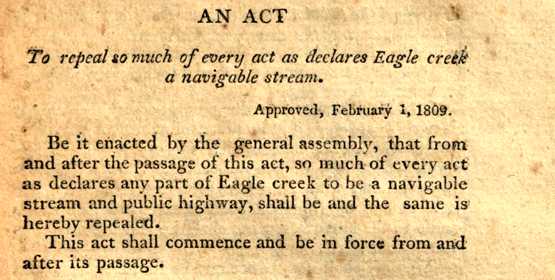
from the Yeah-We-Knew-That Department
an ACT of the Kentucky Legislature
The Bridges
![]()





